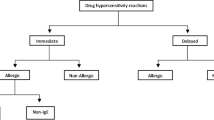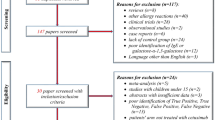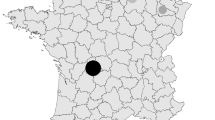Abstract
Introduction
Monoclonal antibodies (MAbs) targeting epidermal growth factor receptor (EGFR) are effective in treatment of metastatic colorectal cancer (mCRC). Cetuximab, a chimeric MAb targets EGFR. Even with premedication, cetuximab can cause a hypersensitivity reaction (HSR). In case of severe HSR, further therapy with cetuximab is contraindicated, thus preventing these patients from receiving potentially beneficial anti-EGFR therapy. Panitumumab is a fully human MAb also targets EGFR. To date, no human antihuman Ab have been detected, and unlike CET, HSR are infrequent, and no premedication is required. Safety of panitumumab in patients with a previous severe HSR with cetuximab is not fully known. We present three patients with GI cancers who tolerated panitumumab without HSR after experiencing severe HSR to cetuximab.
Patients and methods
Three patients were challenged with standard dose of panitumumab (6 mg/kg) after experiencing grade 3 HSR to standard dose of cetuximab under strict observation and no premedication. First patient, a 58-year-old male with mCRC developed grade 3 HSR during 8th dose of cetuximab. Second patient was a 58-year-old female with mCRC developed grade 3 HSR during 12th dose of cetuximab. Third patient was a 61-year-old male with pancreatic cancer who experienced grade 3 HSR during loading dose of cetuximab. Charts were reviewed to find history of prior allergy, including H1 blocker use, drug allergy, bee sting allergy, eczema, allergic reactive airways disease, or food allergy.
Results
All patients were Caucasians with an average age of 59 year with no history of prior allergy. No patient received any premedication. First patient received panitumumab for 2 months, second patient was treated for 6 months, and third patient who was rechallenged 1 week after HSR to cetuximab had a partial response following 6 months of therapy.
Conclusions
HSR are serious complications associated with MAbs. Thanks to hybridoma technology that newer generations of MAbs contain less or no mouse-specific protein sequences, hence reducing the risk of HSR. Identification of individuals likely to develop severe and sometimes life-threatening HSR is challenging. Our report of three patients successfully treated with panitumumab after they had severe HSR to cetuximab warrant further investigation.

Similar content being viewed by others
References
Ritter CA, Arteaga CL (2003) The epidermal growth factor receptor—tyrosine kinase: promising therapeutic target in solid tumors. Semin Oncol 30:3–11
Mendelsohn J (2002) Targeting the epidermal growth factor receptor for cancer therapy. J Clin Oncol 20(18 Suppl):1S–13S
Ennis BW, Lippman ME, Dickson RB (1991) The EGF receptor system as a target for antitumor activity. Cancer Invest 9:553–562
Khazaeli MB, LoBuglio AF, Falcey JW et al (2000) Low immunogenicity of a chimeric monoclonal antibody (MAb), IMC-C225, used to treat epidermal growth factor receptor-positive tumors. Proc Am Soc Clin Oncol 19:207a Abs 808
Saltz L, Meropol N, Loehrer PJ et al (2004) Phase II trial of cetuximab in patients with refractory colorectal cancer that express the epidermal growth factor receptor. J Clin Oncol 22:1201–1208
Cunningham D, Humblet Y, Siena S et al (2004) Cetuximab monotherapy and cetuximab plus irinotecan in irinotecan-refractory metastatic colorectal cancer. N Engl J Med 351:337–345
Baselga J, Pfister D, Cooper MR et al (2000) Phase I studies of anti-epidermal growth factor receptor chimeric antibody C225 alone and in combination with cisplatin. J Clin Oncol 18:904–914
Lynch DH, Yang XD (2002) Therapeutic potential of ABX-EGF: a fully human anti-epidermal growth factor receptor monoclonal antibody for cancer treatment. Semin Oncol 29(Suppl 4):47–50
Patel DD, Goldberg RM (2006) Cetuximab-associated infusion reactions: pathology and management. Oncology (Williston Park) 20(11):1373–1382
Kimby E (2005) Tolerability and safety of rituximab (MabThera). Cancer Treat Rev 31(6):456–473 Epub 2005 July 28
Kullmann F, Hollerbach S, Dollinger MJ (2007) Cetuximab plus gemcitabine/oxaliplatin (GEMOXCET) in 1st line metastatic pancreatic cancer. First results from a multicenter phase II study. Gastrointestinal cancers symposium Abs 128
Lacouture ME, Melosky BL (2007) Cutaneous reactions to anticancer agents targeting the epidermal growth factor receptor: a dermatology-oncology perspective. Skin Therapy Lett 12(6):1–5
Saif MW, Kim R (2007) Incidence and management of cutaneous toxicities associated with cetuximab. Expert Opin Drug Saf 6(2):175–182
Cohenuram M, Saif MW (2007) Panitumumab the first fully human monoclonal antibody: from the bench to the clinic. Anticancer Drugs 18(1):7–15
Roskos L, Lohner M, Schwab G (2001) A biomathematical model of neoplastic cell growth and prediction on silico of effective doses of ABX-EGF in cancer patients. Proced Am Assoc Cancer Res 42:833 Abs 4471
Berlin J, Malik I, Picus J (2004) Panitumumab therapy with irinotecan, 5-fluorouracil, and leukovorin (IFL) in metastatic colorectal patients. Proc of the Eur Soc of Med Onc Abs 265PD
Malik I, Hecht JR, Patnaik A, Venook A, Berlin J, Croghan G, Navale L, MacDonald M, Jerian S, Meropol NJ (2005) Safety and Efficacy of panitumumab monotherapy in patients with metastatic colorectal cancer. Proc Am Soc Clin Oncol Abs 3520
Hecht JR, Berlin J, Malik I, Picus J, Glisson S, Kozloff M, Spitzer G, Arends R, Hollifield A, Yang B (2005) Panitumumab therapy with irinotecan, 5-fluorouracil, and leukovorin (IFL) in metastatic colorectal patients: a pharmacokinetic analysis. Program of the Am Soc Clin Onc. Gastrointestinal cancers symposium Abs 259
Lenz HJ (2007) Management and preparedness for infusion and hypersensitivity reactions. Oncologist 12(5):601–609
Melichar B, Cerman J Jr, Malírová E (2007) Successful management of infusion reaction accompanying the start of cetuximab therapy. Support Care Cancer 15(4):445–449
Needle MN (2002) Safety experience with IMC-C225, an anti-epidermal growth factor receptor antibody. Semin Oncol 29(5 Suppl 14):55–60
O’Neil BH, Allen R, Spigel DR, Stinchcombe TE, Moore DT, Berlin JD, Goldberg RM (2007) High incidence of cetuximab-related infusion reactions in Tennessee and North Carolina and the association with atopic history. J Clin Oncol 25(24):3644–3648
Chung CH, Mirakhur B, Chan E, Le QT, Berlin J, Morse M, Murphy BA, Satinover SM, Hosen J, Mauro D, Slebos RJ, Zhou Q, Gold D, Hatley T, Hicklin DJ, Platts-Mills TA (2008) Cetuximab-induced anaphylaxis and IgE specific for galactose-alpha-1, 3-galactose. N Engl J Med 358(11):1109–1117
Milland J, Sandrin MS (2006) ABO blood group and related antigens, natural antibodies and transplantation. Tissue Antigens 68:459–466
Paschinger K, Fabini G, Schuster D et al (2005) Definition of immunogenic carbohydrate epitopes. Acta Biochim Pol 52:629–632
van der Veen MJ, van Ree R, Aalberse RC et al (1997) Poor biologic activity of cross-reactive IgE directed to carbohydrate determinants of glycoproteins. J Allergy Clin Immunol 100:327–334
Adédoyin J, Gronlund H, Oman H, Johansson SG, van Hage M (2007) Cat IgA representative of new carbohydrate cross-reactive allergens. J Allergy Clin Immunol 119(3):640–645
Saif MW, Cohenuram M (2006) Role of panitumumab in the management of metastatic colorectal cancer. Clin Colorectal Cancer 6(2):118–124
Heun J, Holen K (2007) Treatment with panitumumab after a severe infusion reaction to cetuximab in a patient with metastatic colorectal cancer: a case report. Clin Colorectal Cancer 6(7):529–531
Helbling D, Borner M (2007) Successful challenge with the fully human EGFR antibody panitumumab following an infusion reaction with the chimeric EGFR antibody cetuximab. Ann Oncol 18(5):963–964
Author information
Authors and Affiliations
Corresponding author
Rights and permissions
About this article
Cite this article
Saif, M.W., Peccerillo, J. & Potter, V. Successful re-challenge with panitumumab in patients who developed hypersensitivity reactions to cetuximab: report of three cases and review of literature. Cancer Chemother Pharmacol 63, 1017–1022 (2009). https://doi.org/10.1007/s00280-008-0831-6
Received:
Revised:
Accepted:
Published:
Issue Date:
DOI: https://doi.org/10.1007/s00280-008-0831-6




